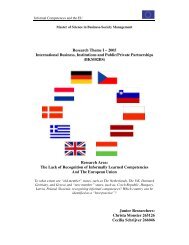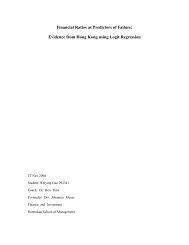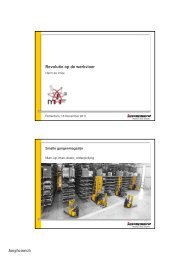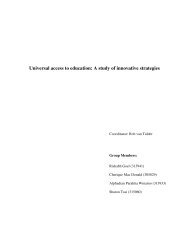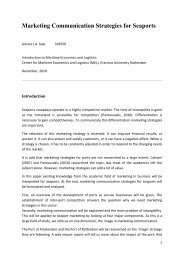here - ERIM - Erasmus Universiteit Rotterdam
here - ERIM - Erasmus Universiteit Rotterdam
here - ERIM - Erasmus Universiteit Rotterdam
Create successful ePaper yourself
Turn your PDF publications into a flip-book with our unique Google optimized e-Paper software.
A validation Study of House of Quality key performance indicators<br />
for members to understand the possibilities and what can be expected. From this perspective an<br />
adjusted R2 of 24,3% in this case is acceptable.<br />
4.3 Establishing the House of Quality; translating “What” into “How”<br />
In section 4.2 the dataset of items established from the perception and expectation ratings was<br />
statistically tested. Factor analysis examined the structure of the dimensions w<strong>here</strong>as a regression<br />
analysis was conducted to test the unique effects of the established dimensions on member’s overall<br />
rating of the online union. In this section we will integrate the data gat<strong>here</strong>d by substracting the<br />
expectations from the perceptions plus the data from the Kano related part of the survey into the<br />
first matrix of Quality Function Deployment; the House of Quality.<br />
Section 4.3.1 discusses the gap analysis between the expectations and perceptions. Section 4.3.2 will<br />
present the Kano analysis. Involvement of the management team as experts in the data collection for<br />
the QFD process is described in section 4.3.3. The compositition of the House of Quality will be<br />
presented in section 4.3.4.<br />
4.3.1 Gap analysis<br />
Based on the SERVQUAL method, the first part of the survey measured the quality of the services<br />
provided by the online union. As discussed in section 2.4 gaps occur when t<strong>here</strong> are differences<br />
between customer’s expectation and the actual perception of the service provided; the wider the<br />
gap, the larger the difference. Positive scores means that the perceptions of a service exceeds the<br />
expactations w<strong>here</strong>as a score of zero indicates satisfactory quality. Negative scores on the other<br />
hand submit to an underperformance in relation to the customer’s expactations.<br />
Each item is measured by two questions. In our survey the first question measures the expectations<br />
of a member by asking to indicate on a five-point Likert scale how a specific situation in general<br />
should be. The second question measures the same situation but than specifically in the case of the<br />
online union. For example; the first announcement will be “A trade union organization should have<br />
good online facilities”, followed by “The online union has good online facilities”.<br />
All items in the survey measured negative gaps. An overview of the gap scores is presented in Figure -<br />
11. A possible explanation for the negative gaps might be the fact that people have the intention to<br />
respond more extremly when they are asked to indicate an ideal situation. T<strong>here</strong>fore the focus<br />
should be on the variation of the gaps instead of the negative values (Teas, 1993b). The measured<br />
gaps can be very valuable to the organization as it clearly indicates on which service aspects the<br />
organization is underperforming. This study focusses on the process of improvement, t<strong>here</strong>fore the<br />
gaps are valuable as input for the House of Quality but not as single indicators.<br />
62




